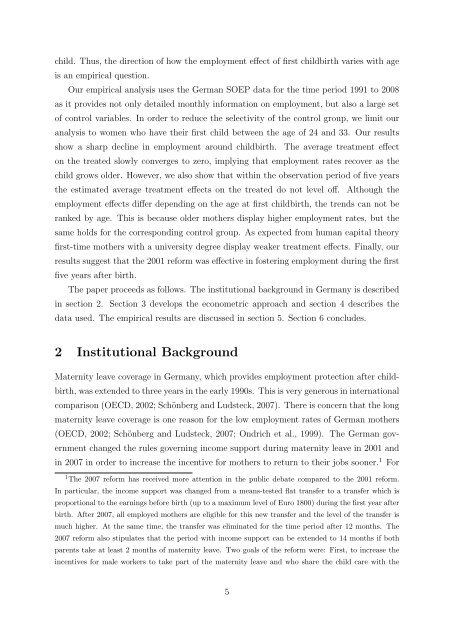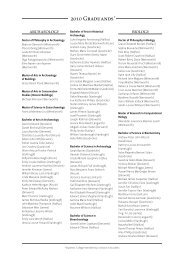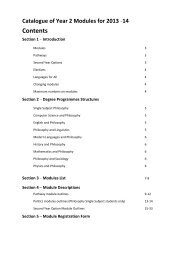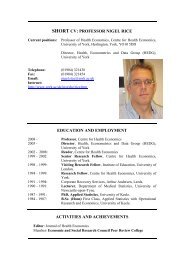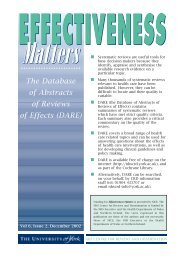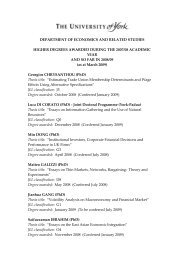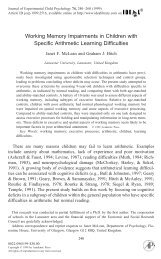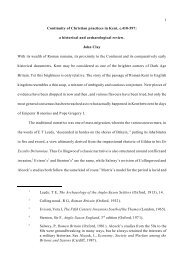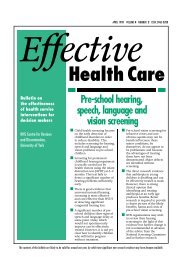Causal effects on employment after first birth - A ... - University of York
Causal effects on employment after first birth - A ... - University of York
Causal effects on employment after first birth - A ... - University of York
Create successful ePaper yourself
Turn your PDF publications into a flip-book with our unique Google optimized e-Paper software.
child. Thus, the directi<strong>on</strong> <strong>of</strong> how the <strong>employment</strong> effect <strong>of</strong> <strong>first</strong> child<strong>birth</strong> varies with ageis an empirical questi<strong>on</strong>.Our empirical analysis uses the German SOEP data for the time period 1991 to 2008as it provides not <strong>on</strong>ly detailed m<strong>on</strong>thly informati<strong>on</strong> <strong>on</strong> <strong>employment</strong>, but also a large set<strong>of</strong> c<strong>on</strong>trol variables. In order to reduce the selectivity <strong>of</strong> the c<strong>on</strong>trol group, we limit ouranalysis to women who have their <strong>first</strong> child between the age <strong>of</strong> 24 and 33. Our resultsshow a sharp decline in <strong>employment</strong> around child<strong>birth</strong>. The average treatment effect<strong>on</strong> the treated slowly c<strong>on</strong>verges to zero, implying that <strong>employment</strong> rates recover as thechild grows older. However, we also show that within the observati<strong>on</strong> period <strong>of</strong> five yearsthe estimated average treatment <str<strong>on</strong>g>effects</str<strong>on</strong>g> <strong>on</strong> the treated do not level <strong>of</strong>f. Although the<strong>employment</strong> <str<strong>on</strong>g>effects</str<strong>on</strong>g> differ depending <strong>on</strong> the age at <strong>first</strong> child<strong>birth</strong>, the trends can not beranked by age. This is because older mothers display higher <strong>employment</strong> rates, but thesame holds for the corresp<strong>on</strong>ding c<strong>on</strong>trol group. As expected from human capital theory<strong>first</strong>-time mothers with a university degree display weaker treatment <str<strong>on</strong>g>effects</str<strong>on</strong>g>. Finally, ourresults suggest that the 2001 reform was effective in fostering <strong>employment</strong> during the <strong>first</strong>five years <strong>after</strong> <strong>birth</strong>.The paper proceeds as follows. The instituti<strong>on</strong>al background in Germany is describedin secti<strong>on</strong> 2. Secti<strong>on</strong> 3 develops the ec<strong>on</strong>ometric approach and secti<strong>on</strong> 4 describes thedata used. The empirical results are discussed in secti<strong>on</strong> 5. Secti<strong>on</strong> 6 c<strong>on</strong>cludes.2 Instituti<strong>on</strong>al BackgroundMaternity leave coverage in Germany, which provides <strong>employment</strong> protecti<strong>on</strong> <strong>after</strong> child<strong>birth</strong>,was extended to three years in the early 1990s. This is very generous in internati<strong>on</strong>alcomparis<strong>on</strong> (OECD, 2002; Schönberg and Ludsteck, 2007). There is c<strong>on</strong>cern that the l<strong>on</strong>gmaternity leave coverage is <strong>on</strong>e reas<strong>on</strong> for the low <strong>employment</strong> rates <strong>of</strong> German mothers(OECD, 2002; Schönberg and Ludsteck, 2007; Ondrich et al., 1999). The German governmentchanged the rules governing income support during maternity leave in 2001 andin 2007 in order to increase the incentive for mothers to return to their jobs so<strong>on</strong>er. 1 For1 The 2007 reform has received more attenti<strong>on</strong> in the public debate compared to the 2001 reform.In particular, the income support was changed from a means-tested flat transfer to a transfer which isproporti<strong>on</strong>al to the earnings before <strong>birth</strong> (up to a maximum level <strong>of</strong> Euro 1800) during the <strong>first</strong> year <strong>after</strong><strong>birth</strong>. After 2007, all employed mothers are eligible for this new transfer and the level <strong>of</strong> the transfer ismuch higher. At the same time, the transfer was eliminated for the time period <strong>after</strong> 12 m<strong>on</strong>ths. The2007 reform also stipulates that the period with income support can be extended to 14 m<strong>on</strong>ths if bothparents take at least 2 m<strong>on</strong>ths <strong>of</strong> maternity leave. Two goals <strong>of</strong> the reform were: First, to increase theincentives for male workers to take part <strong>of</strong> the maternity leave and who share the child care with the5


